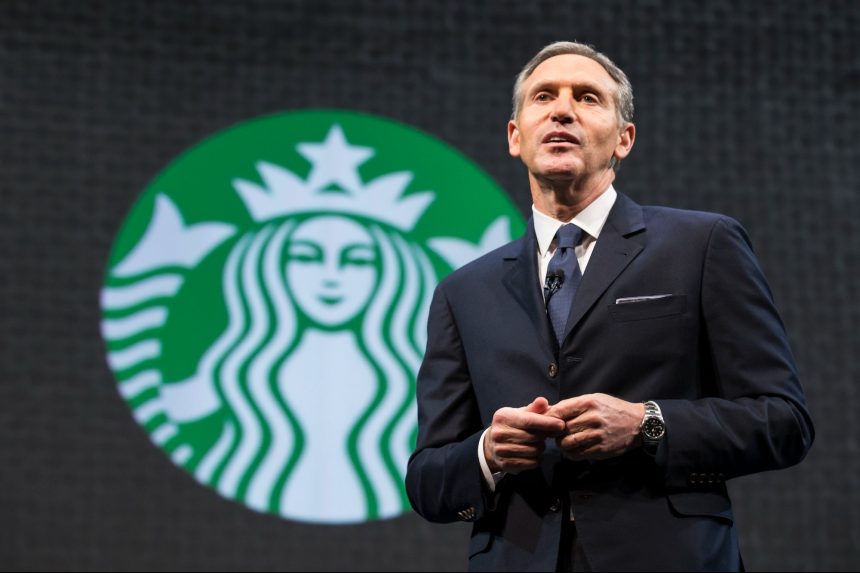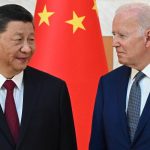Starbucks is bidding farewell to former CEO Howard Schultz after he stepped down from the company’s board on Wednesday, September 13, after over 40 years on the job and three stints at the top of the coffee giant.
Schultz, who first served as CEO from 1987 to 2000 and then again from 2008 to 2017, has been executive chairman and a member of the board since 2018. He returned to the position as interim CEO after Kevin Johnson stepped down from the role in April 2022. This time around, he only held the job for 11 months before announcing Laxman Narasimhan as the company’s new CEO in October.
Starbucks is now honoring Schultz with the title of “lifelong Chairman Emeritus” in the wake of his exit from the board.
“I look forward to supporting this next generation of leaders to steward Starbucks into the future as a customer, supporter, and advocate in my role as chairman emeritus,” Schultz said in a press release.
Stephen Brashear/Getty Images | Starbucks Chairman and CEO Howard Schultz speaks during Starbucks annual shareholders meeting March 18, 2015 in Seattle, Washington.
Wei Zhang, who formerly served as president of Alibaba Pictures Group and senior advisor to Alibaba, will be assuming Schultz’s seat on the board. She is set to step into the role on October 1.
Keep scrolling for more details about Howard Schultz and Wei Zhang.
RELATED: Entrepreneurial Lessons From Howard Schultz and Starbucks: How To Tide Over Recession With Reinvigoration
Who Is Howard Schultz?
Howard Schultz was born on July 19, 1953, and was raised in Brooklyn, New York. He studied at Northern Michigan University before going on to work in sales and marketing for the Xerox Corporation and a Swedish houseware company.
He was first introduced to Starbucks as a consumer in 1981 before moving to Seattle to be the company’s director of operations and marketing just one year later, his company biography states. He was made CEO in 1987.
When he first started, Starbucks only had four locations, but he grew the brand to over 3,000 stores by the time he stepped down from CEO the first time in 2000. He worked as the company’s global chief strategist until returning to the role of CEO in 2008. At that point, Starbucks had 15,000 stores, but he expanded the brand again to 30,000 stores by the time he retired in 2018.
RELATED: ‘The Most Vile Coffee Drink I Have Ever Had’: Starbucks’ Olive Oil-Infused Beverages Are Coming to More Cities
He has continued to be a member of the board since his retirement but briefly came back as interim CEO in April 2022 until Laxman Narasimhan took on the job.
Schultz has been married to his wife Sherri Kersch Shultz since 1982. Together they share two children, Eliahu Jordan Schultz and Addison Schultz.
What Is Howard Schultz’s Net Worth?
Howard Schultz has an estimated net worth of $3.2 billion, per Forbes. Schultz is also the founder of the venture capital firm Maveron, where he has invested in several major companies including Groupon and Allbirds. He also started the Schultz Family Foundation which focuses on training and hiring veterans.
RELATED: Starbucks’ Pumpkin Spice Latte Is Celebrating a 20-Year Reign Nobody Expected, Especially Its Co-Creator
Who Is Wei Zhang?
Wei Zhang’s election to Starbucks’ board of directors makes her the third woman on the nine-seat board.
In addition to her decade at Alibaba, where she led the brand’s corporate development and strategy, she also held roles at News Corp China, CNBC China, Bain & Company, and General Electric, per CNBC.
She’s currently a Ralph Lauren Corporation board member. Zhang has a long history as a board member and formerly sat on the boards of the Los Angeles Sports & Entertainment Commission, Amblin Partner, the Jack Ma Foundation, and more.
“I’ve been a Starbucks customer across the globe for decades,” Zhang said in a press release announcing her new role. “I’m honored to have the opportunity to work with the board and talented leadership team to contribute to the power, relevance, and resilience of the Starbucks business and brand – creating significant value for all stakeholders.”
Read the full article here










